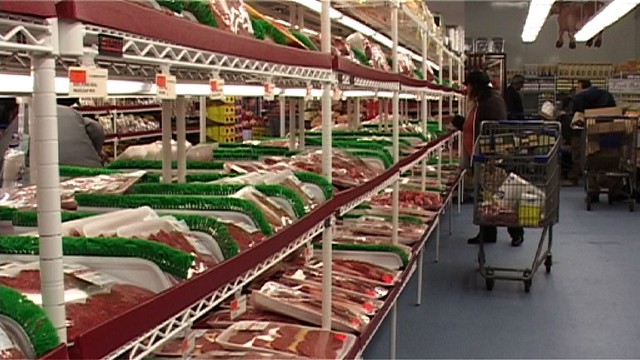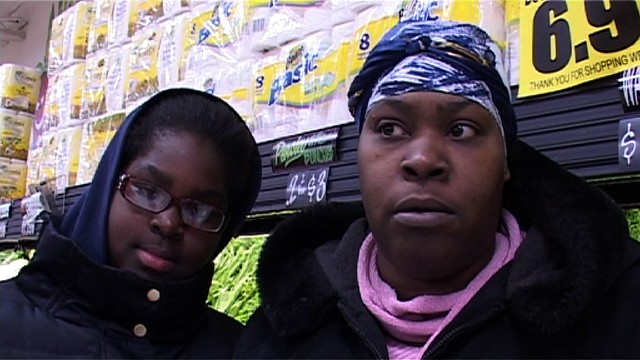Rising Food Cost Challenging New York City
For Monique James, a mother of five from New York’s congressional district 16th in the Bronx, feeding her family has never been an easy task. This year, it is even harder when she finds herself constantly short of money.
“The cost of living is just harmful for poor people like myself, and I’d have to say my food budget has increased $200 a month,” said James. “Every food item and every store have gone up, so the price is not really affordable now.”
Like millions of other low-income Americans, James is bearing the brunt of food inflation. According to the Bureau of Labor Statistics, food at home for urban consumers inflated by 6.2 percent in the year ending October 2011.
“One of the few benefits for low income people in America compared to other developed countries that had higher wages, and higher-developed social safety nets was at least we had lower food prices,” said Joel Berg, a food security expert and executive director of the New York City Coalition Against Hunger. “With the sky-rocketing food prices over the last few years, low-income Americans have lost even that one minimum advantage.”
Despite being one of the country’s most prosperous cities, New York is still facing food insecurity challenges. More than 20 percent of residents in 9 of the city’s 13 congressional districts lacked money for food in 2010, according to the Food Hardship in America Report released earlier this year by the Food Research and Action Center.
The situation is the worst in congressional district 16, where 32.7 percent, or almost one in three people could not afford enough food. The report also shows that district 16 is not only the hungriest area in NYC, but also the hungriest in the whole nation.
“[District 16] is one of the poorest congressional districts in the country, and it has had high level of hunger and food insecurity for years,” commented Berg. “The reason is pretty simple: not enough people have jobs, those people who have jobs are often underpaid or don’t work full-time, and the federal nutrition safety net is not as strong as it needs to be.”
James has been unemployed for six years due to multiple health issues, and relies on the Supplemental Nutrition Assistance Program, commonly known as “food stamps”, to feed her family. But the challenge of getting by on food stamps is big. Fresh fruit and vegetables have become a luxury that she has to cut back on to make ends meet, and balancing her children’s calorie and nutritional needs has also become more difficult.
“I would really have to say I have to cut back on vegetables because they are going up extremely,” said James. “For the kids, I try to give them more vegetable and cut back on starch, but it doesn’t help, because they are growing kids, they love to eat, and their metabolism burns.”
According to the Bureau of Labor Statistics, meat, poultry, fish and eggs cost 7.4 percent more than last year, while dairy products were 9 percent more expensive.
Statewide, SNAP participation rate has soared by 53 percent over the past three years. In NYC there are 1.8 million residents likes James relying on SNAP to put food on their tables.
As vital as SNAP is to combat hunger in America, the food assistance program has often found itself on the chopping block when it comes to funding cuts. Last year, Congress passed two bills that cut the SNAP benefit boosts, making room for approximately 10 percent reduction in average per person benefits.
The 2012 Agricultural Appropriations Bill, signed by President Obama late last month, allocates an extra $14 billion to food stamp funding. Anti-hunger activists welcomed the bill, seeing it as the necessary reversal of the devastating cuts that have already been implemented.
“Even with higher level of SNAP food stamp, there are 49 million Americans living in households that cannot afford enough food,” said Berg. “If we take away billions of extra food dollars from those struggling families, that has been proposed by congress and actually implemented, if that’s not reversed you are really going to see mass suffering in this country.”
With the typical SNAP benefit of just about $4.5 per person per day, James has found that the monthly allowance can only last her family three weeks. She joins the line outside food pantries to get some groceries for the fourth week.
“Before allowing my kids to go hungry, I have to stand in the same line that I donated to for many years, to get me a donation,” shared James. “It’s hard, but you have to do what you have to do to feed the kids.”
According to the Food Bank for NYC, approximately 1.3 million residents in the city, mainly women, children, senior, the working poor and people with disabilities, are relying on soup kitchens and food pantries. They run on both public funding and donations, but these resources have been in the decline due to the bad economy.
Bed-Stuy Campaign Against Hunger Food Pantry in Brooklyn is serving 50 percent more poor families than it did last year, and are finding it difficult to meet the demand. The bad economy has forced many donors to tighten their belt and stop giving, while food inflation has made it much more costly to feed a family in need. To make it worse, distribution organizations like Food Bank and City Harvest now receive less funding and provide pantries with less food.
“We have got very little from TEFAP (The Emergency Food Assistance Program), which would normally be our major supply from the Food Bank,” said Bed-Stuy Campaign executive director Malony Samuels. “It is bad that they are experiencing funding cuts, because that will not just affect us but every emergency food pantry in the New York City area.”
Balancing her family’s food budget amid inflation and funding cuts is already a huge challenge for James. But for her family to get by, sometimes she has to make sacrifices that she knows may cause even more harm.
“I have to take medications, but I’m not getting my full meds because either I get my meds or I feed my kids, and of course, I choose to feed my kids,” she said. “But if I don’t take care of myself I won’t be able to feed them, then it’s no good.”
Click here for the full article.



